Notes by an Egyptian resident artist in Jung-gu1
Welcome to Jung-gu
약 한 달 전, 나는 중구에 첫발을 디뎠다. 그리고 인천아트플랫폼의 아름다운 건물들을 마주했다. 첫날부터 중구는 나에게 사뭇 익숙하면서도 낯선 느낌을 선사했다. 이런 익숙함은 내 고국인 이집트의 관습과 비슷한 면을 발견했기 때문일지도 모른다. 혹은 한국의 현대 가정에 대해 우연히 알게 된 모습이나 중구문화회관에서 본 이미지 때문에 느껴졌을지도 모르겠다. 그렇다면 낯설다는 이 감정은 어디에서 온 걸까. 나는 언어장벽에서 비롯되었으리라고 추측했다. 사실 지금까지 방문했던 나라는 모두 내 모국어인 아랍어나 로마자를 사용했기 때문에 글자를 읽을 수조차 없는 장소를 방문해보는 경험은 나에게 처음 있는 일이었다. 고요한 분위기도 내가 느꼈던 낯선 감정의 또 다른 이유였음을 알았다. 내가 기억하는 이집트는 갈수록 악화된 생활환경 때문에 언제나 억압된 분노를 품고 있었다. 캐나다의 경우, 특히나 지금 사는 토론토는 부조리한 틀로 인해 시민들이 지속적인 스트레스와 압박감에 시달리는 것처럼 보인다. 하지만 인천은 달랐다. 나에게 인천은 평화로운 환경의 대명사였다.
중구처럼 풍부한 문화와 역사로 가득 찬 곳에 도시와 함께 숨 쉴 때 나는 안정감이 차오르는 걸 느낀다. 문화와 역사가 공간을 구석구석 층층이 감싸 안으며 발산하는 온기야말로 캐나다로 온 뒤 진정 그리워하고 있는 부분이다. 중구를 떠난 후 내가 가슴으로 기억하는 것들이 있음을 깨달았다. 자유공원에 올라 항구를 바라보거나 제물량로를 걸어 내려갈 때, 곳곳의 작은 요소들은 언제나 내 시선을 붙잡고 영감을 불어넣어 주었다. 나는 늘 이곳저곳을 돌아다니고 사람들에게 인사하다가 모퉁이를 돌아 닭국수집에 들렀고, 식사 후에는 닭국수집 맞은편의 카페로 향했고, 꽃집 맞은편의 교통경찰관에게 인사했고, 중구에 도착한 첫날 나에게 소고깃국을 끓여주었던 술집 주인과 그의 딸에게 잠깐 들렀다. 그리고 마침내 내 목적지로 향했다. 이 모든 것들이 이곳, 중구에서의 내 삶을 구성하는 중요한 일부였다.
I arrived to Jung-gu a little over a month ago to the beautiful architecture of Incheon art platform. Since the first day, I encountered a familiar yet foreign feeling. Perhaps the familiarity stems from the similarity I find in some of the customs we have in Egypt. Or perhaps in the visuals I came across in the contemporary household in Korea, or the images I saw in the museum of culture in Jung-gu. The foreign feeling however, I believe comes from the Language barrier. It is the first time I visit a place where I can’t read the alphabet. All countries I visited before either spoke Arabic, which is my first language, or used Latin alphabet. The other reason for those foreign feelings stems from the serenity I detect here. Egypt for as long as I can remember has been filled with suppressed anger due to the deteriorating living conditions. While Canada, which is my current place of residence, seems to burden its residents with an unjustifiable stress pattern, especially in the city of Toronto, where I reside. However, Incheon for me is the definition of a peaceful environment.
I find comfort in being in a culturally rich and historical place such as Jung-gu. It provides layers and layers to explore and encompass the space with warmth, something that I really miss in Canada. When I take a walk up Freedom Park and look at the port or when I take a walk down Jemullyang-ro which I now know by heart, new details catch my attention every time and stir thoughts in me. I now walk around and greet people, I first stop by the chicken noodle place around the corner, then the café opposite from it, then the traffic policeman across from the flower shop and the bar owner and her daughter who made me a beef stew the first day I arrived, and afterwards I head to my destination. Each one of them has become part of my life here in Jung-gu.
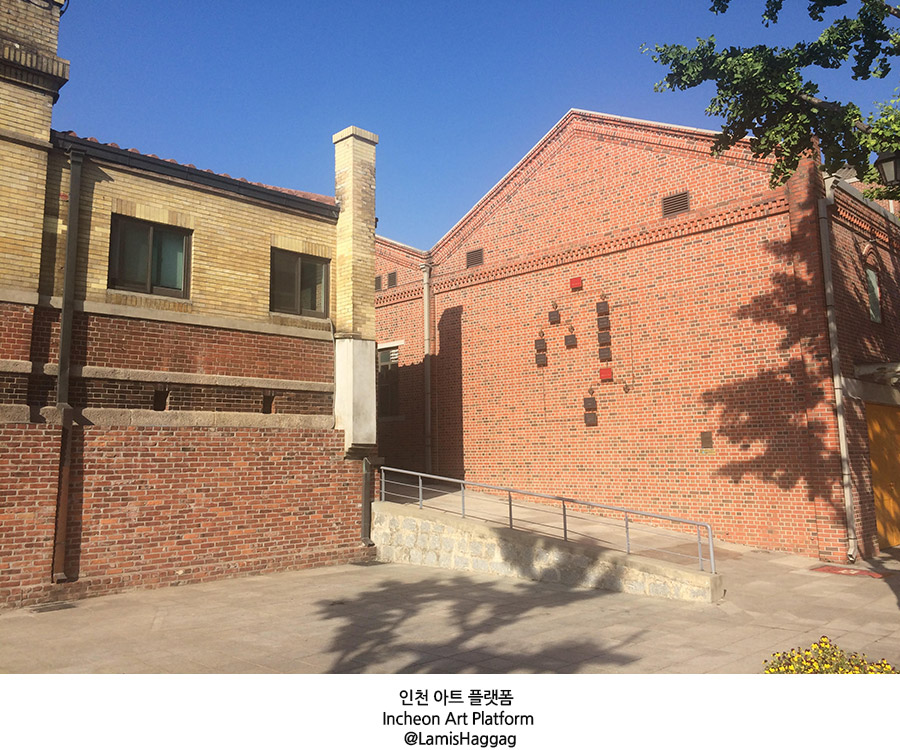
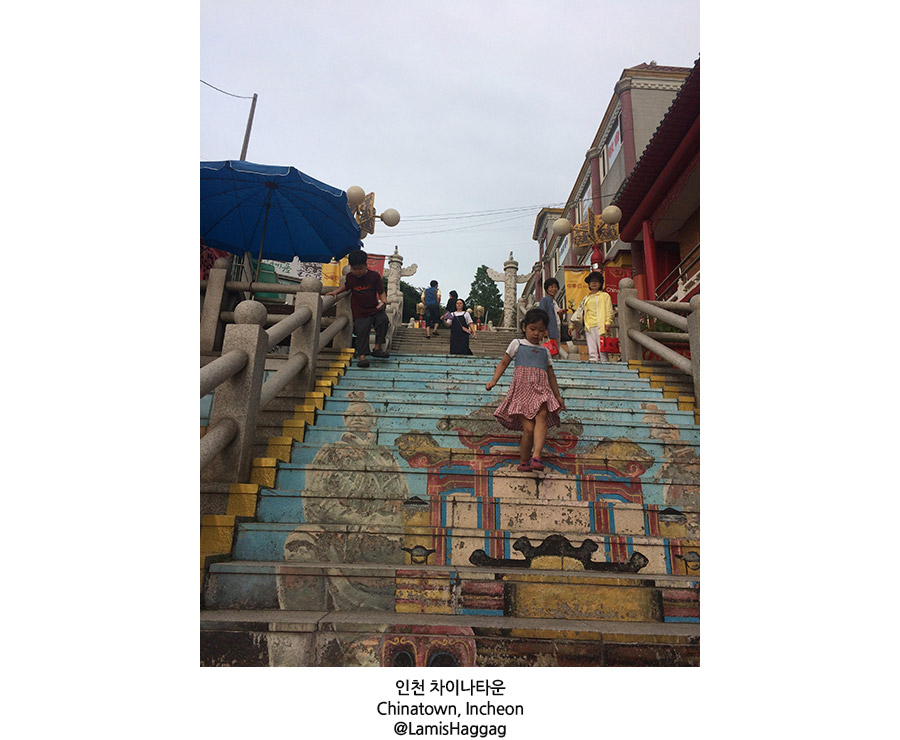
인천과 개항장
언어 장벽으로 인해 이해할 수 없는 부분을 어떻게든 채우고 싶었던 나는 인천의 문화에 대해 배우고자 했다. 하지만 이 도시에 대한 문학 서적 중 영어로 된 책은 도저히 찾을 수가 없었다. 그래서 시각자료를 대신 이용하거나 영어로 말할 수 있는 소수의 사람과 대화하며 도시와 문화에 대해 배워나가기 시작했다. 이 공간이 지켜온 유구한 역사에 대해 알아갈수록 나는 스스로 겸허해짐을 느꼈다.
나는 바다에 특별한 애착이 있다. 덕분에 어느 장소를 가더라도 바다와 호수와 강을 자연스럽게 찾게 되었다. 나의 아버지는 지중해의 한 도시에서 자랐고, 나는 이집트의 카이로에서 성장했다. 카이로를 가로지르는 대교를 건너며 나는 매일 나일강을 떠올렸다. 하지만 왠지 인천의 항구는 가깝지만 멀게 느껴졌고, 사실 지금까지도 가까이 갈 수 없는 존재처럼 느껴진다. 하지만 좀 더 가까이에서 탁 트인 전경의 항구를 볼 수 있는 장소를 찾아내는 걸 아직은 포기하지 않았다.
Incheon and the open port
I wanted to learn about the culture in Incheon, to get a better understanding of what I am lacking because of language, but I was unable to find any English literature about the city. So, I began to read the city and the culture though the visuals and through talking to the few people who speak English. There is a sense of humbleness that I feel here, which I believe comes from the fact that this place has witnessed so much history.
I have this connection to water that compels me to seek the view of the sea, ocean, lake or river, wherever I am. My father is from a city of the Mediterranean, and I grew up in Cairo where the image of the Nile River while crossing the main bridge above Cairo was a daily encounter for me. However, the port here seems so close yet so far away, inaccessible to me till now. Still, I am in search for a clear and close viewing point.
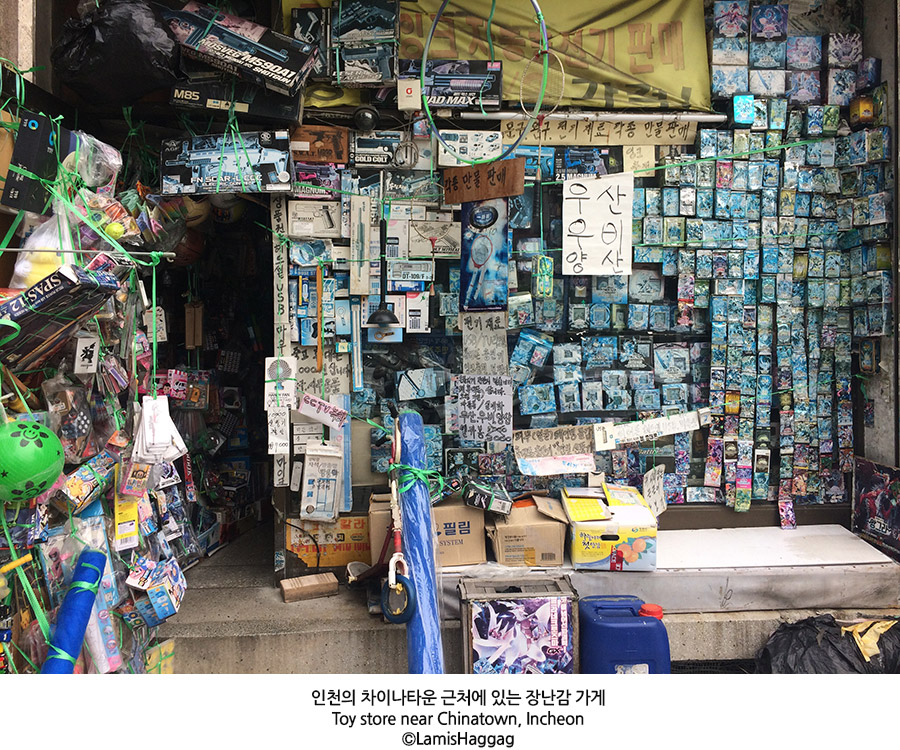
강화도로의 여행
크게는 인천, 구체적으로는 중구에서의 내 삶에 대해 시각적인 이야기를 만들기 시작했다. 덕분에 중구에서만 나는 직물에 대해 찾아보게 되었고 소창이라는 이름의 섬유를 알게 되었다. 소창은 100% 면직물로 강화도에서만 나는 특산품이다. 200개의 공장 중 10개만 남아 다음 세대로 물려온 소창 직물 산업은 시간과 현대의 소비패턴을 거스른다.
수리(Suri)는 문화 이벤트를 기획하고 강화도 장인의 작품을 홍보하는 청풍이라는 팀에 소속된 코디네이터로, 이번 여행 전반에 걸쳐 동행하며 지역에 대해 안내해주었다. 우리는 강화도 외포항젓갈수산시장에서 여정을 시작했는데 그곳에서 매우 맛있는 일본식 밴댕이 피자를 먹어볼 기회를 얻었다. 밴댕이 피자는 보통 고대 이집트의 달력에 따라 춘절을 축하하며 이집트에서 먹곤 했던 젓갈을 연상시켰다. 다음 목적지로 우리는 소창체험관을 방문했다. 강화도의 토종 새와 특산품이 새겨진 스탬프를 직물에 찍기도 하고 소창의 역사에 대한 다큐멘터리도 시청하며 체험관을 마음껏 즐겼다. 쑥차를 마신 후 기념품을 한 아름 선물 받기도 했다. 체험관을 나와서는 안내에 따라 자동차를 타고 오늘날까지 4대에 걸쳐 소창을 생산해온 공장으로 향했다. 생산 과정의 정교함은 물론이거니와 직조기의 아름다운 형태와 주변 풍경이 어우러지는 모습은 절로 감탄을 자아냈다. 소창의 다양한 사용처에 대해 열정적으로 설명해주던 거주민들의 모습도 매우 인상 깊었다. 공장 견학 후에는 나의 거주지 프로젝트를 위해 많은 면직물을 두 손 가득 들고 인천 아트 플랫폼으로 돌아왔다.
A trip to Ganghwa Island
I began to compose a visual story for my project at the residency about Jung-gu specifically and Incheon in general. I was in search for fabric that is made in the area, and I found out about the So-Chang fabric, a 100% cotton fabric, that is local to Ganghwa Island. With about 10 factories out of 200 left that have carried on from one generation to the other. The So-Chang industry, defies time and our modern consumerist patterns.
Suri, a coordinator from Cheongpoong team (a team that organizes cultural events and promotes the work of Ganghwa Island artisans) guided and accompanied me throughout the whole trip. First, we began at the salted fish market, where I was treated to a tasty Japanese Sardinella(UM) Pizza, which reminded me of the salted fish we eat in Egypt (usually in celebration of Spring time as per the Ancient Egyptian calendar.) Then we visited the So-Change experience center, where I played with stamps they have of local birds and products on the fabric and watched a documentary about the history of So-Chang. Then after having ‘Mugwort’ tea (ssook) and given so many souvenirs (Seon-mool.) I was driven to the factory, where the center gets their So-Chang. The factory has been working for four generations. The meticulousness of the steps of production, the visual of the beautiful well-crafted machines along with the surrounding landscape and the eagerness of the residents to tell me about the many uses of the So-Chang fabric was overwhelming. I returned back to Incheon Art Platform with so much fabric for my project at the residency.
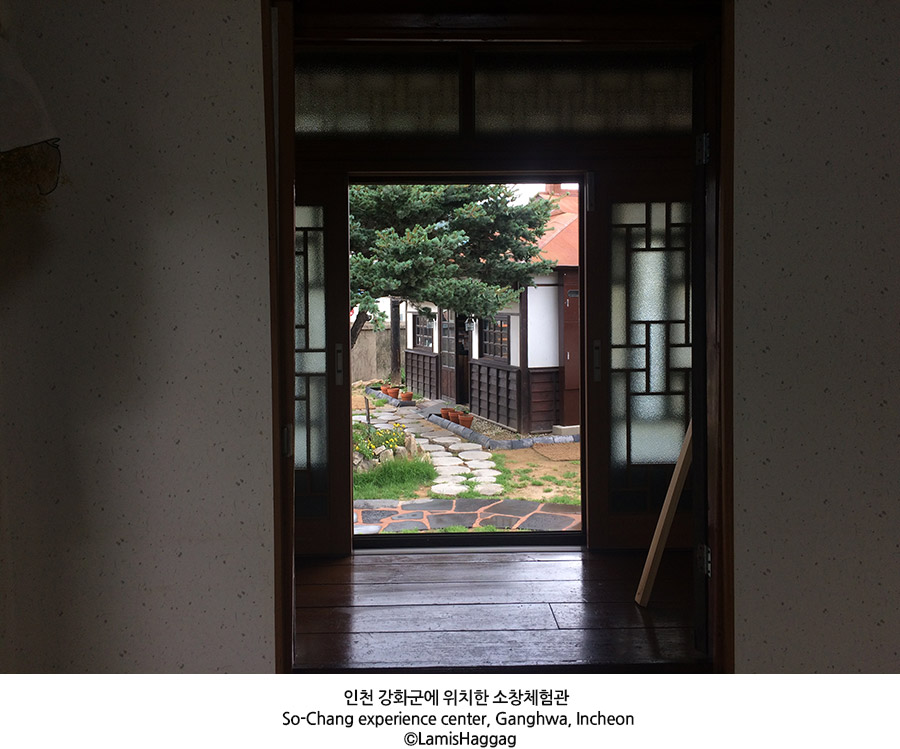
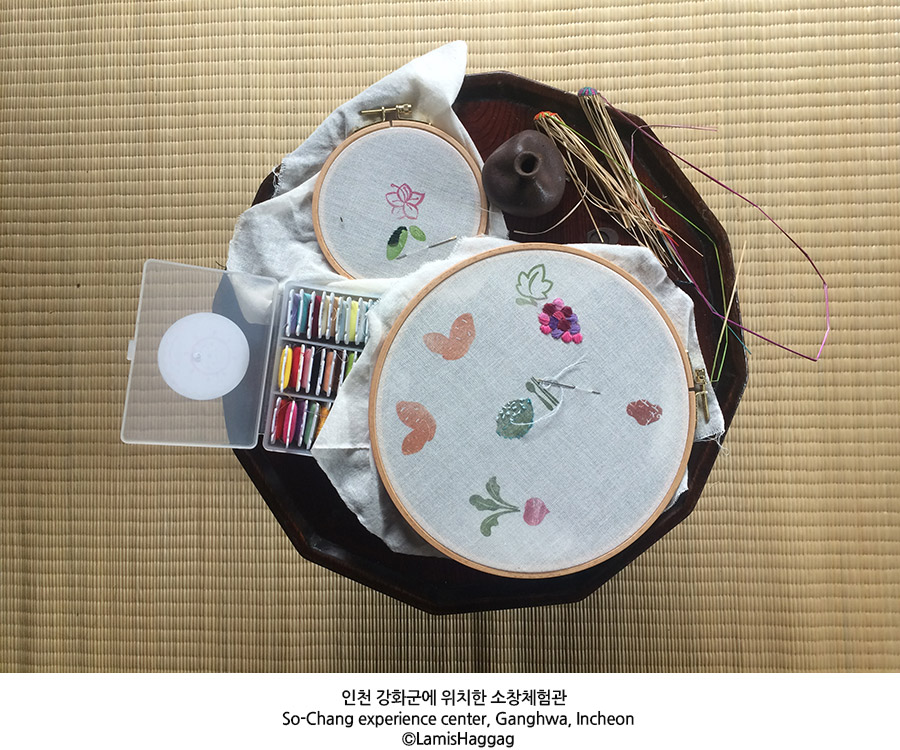

중구의 모습
중구에서의 내 경험은 사람과 나누었던 교류와 결코 잊지 못할 다양한 중구의 모습으로 가득 차 있다. 지하철에 앉아 한강의 ‘채식주의자’를 읽고 다음 식사 장소를 고르기 위해 돌아다녔던 기억. 한국 고유의 음식과 다양한 퓨전 음식을 체험하던 기억. 거리의 상인들이 호객하는 모습을 보며 아침에 내 잠을 여러 번 깨우곤 했던 카이로의 전통 가구 상인을 떠올리던 기억. 한국어를 못해서 손짓, 발짓을 동원하는 외국인을 인내심 있게 기다려주고 알고 있는 한 두 마디 영어를 써서라도 소통하고자 노력해주던 사람들. 지하철로 가는 길목의 나무에 걸려있던 그물을 바라보며 알렉산드리아의 나무 사이에서 그물을 짜는 어부의 모습을 떠올리던 기억. 이 모든 추억과 중구에서의 또 다른 기억들은 앞으로도 내 생각의 일부가 되고 진한 향수로 남아있을 것이다.
Images from Jung-gu
My experience in Jung-gu is based mostly on simple interactions with the people and on a variation of visuals that I will not forget. Sitting in the subway reading Han Kang’s, ‘The Vegetarian’and walking around to select my next dining experience. Exploring the Korean cuisine and the different fusions. Listening to the street vendorscalling for their merchandise and thinking of the Robabekya (old furniture) vendor that I have so many times woken up to in the morning in Cairo. Talking to the people with my hands and one or two English words that they know and appreciating their patience in dealing with a non-Korean speaker. Watching the fishing net hung between the trees on my way to the subway station and remembering the image of fishermen weaving their nets between the trees in Alexandria. All those memories and many more shall become part of my thoughts and future reminiscences.
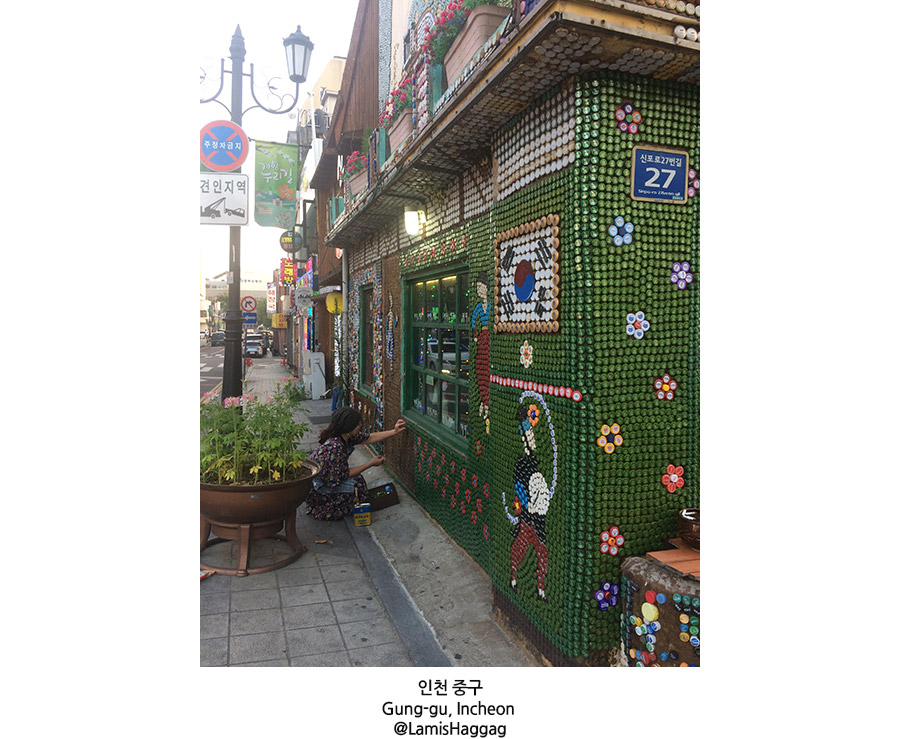
글/사진
라미스 하가그(Lamis Haggag)
작가정보 자세히 보기 ▶
번역/ 공서윤






![[큐레이션 콕콕] 키워드로 보는 2020 코리아](http://news.ifac.or.kr/wp-content/uploads/2019/12/kok01_s-351x185.jpg)
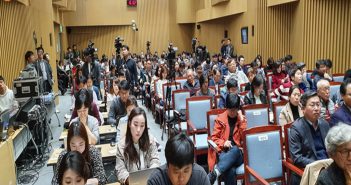
![[큐레이션 콕콕] 요즘, 편의점](http://news.ifac.or.kr/wp-content/uploads/2019/12/191210_2_S-351x185.jpg)